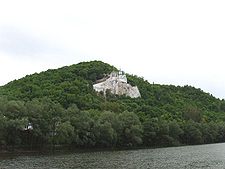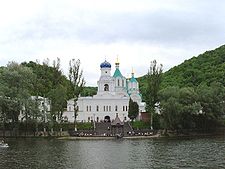
Sviatohirsk Lavra
Encyclopedia



Lavra
In Orthodox Christianity and certain other Eastern Christian communities Lavra or Laura originally meant a cluster of cells or caves for hermits, with a church and sometimes a refectory at the center...
) near the city of Sviatohirsk
Sviatohirsk
Sviatohirsk or Svyatogorsk is a small city in Donetsk Oblast of Ukraine. The population is 5,136 . Before 2003, the city was known as Slovianohirsk or Slavyanogorsk , and before 1964 it was known as Bannovsky or Bannovskoe , so called for the medicinal baths constructed near the Svyatogorsky...
in Donetsk Oblast
Donetsk Oblast
Donetsk Oblast is an oblast of eastern Ukraine. Its administrative center is Donetsk. Historically, the province is an important part of the Donbas region...
(province
Oblast
Oblast is a type of administrative division in Slavic countries, including some countries of the former Soviet Union. The word "oblast" is a loanword in English, but it is nevertheless often translated as "area", "zone", "province", or "region"...
) of eastern Ukraine
Ukraine
Ukraine is a country in Eastern Europe. It has an area of 603,628 km², making it the second largest contiguous country on the European continent, after Russia...
. The lavra is located on the right bank of the Seversky Donets
Seversky Donets
Seversky Donets is a river on the south of the East European Plain. It originates in the Central Russian Upland, north of Belgorod, flows south-east through Ukraine and then again through Russia to join the Don River, about from the Sea of Azov...
River. The name comes from the hill on which it sits—Sviatohirsk or Holy Hill.
History
The first monkMonk
A monk is a person who practices religious asceticism, living either alone or with any number of monks, while always maintaining some degree of physical separation from those not sharing the same purpose...
s to settle the area were in the 14th-15th centuries. The first written mention of the monastery was in 1526. In 1624, the monastery was officially recognized as the Sviatohirsk Uspensky Monastery. During times of the Crimean Khanate
Crimean Khanate
Crimean Khanate, or Khanate of Crimea , was a state ruled by Crimean Tatars from 1441 to 1783. Its native name was . Its khans were the patrilineal descendants of Toqa Temür, the thirteenth son of Jochi and grandson of Genghis Khan...
, the monastery was invaded a couple of times. The monastery was of great importance in the Russian Empire
Russian Empire
The Russian Empire was a state that existed from 1721 until the Russian Revolution of 1917. It was the successor to the Tsardom of Russia and the predecessor of the Soviet Union...
, which was sometimes considered as the Troitse-Sergiyeva Lavra
Troitse-Sergiyeva Lavra
The Trinity Lavra of St. Sergius is the most important Russian monastery and the spiritual centre of the Russian Orthodox Church. The monastery is situated in the town of Sergiyev Posad, about 70 km to the north-east from Moscow by the road leading to Yaroslavl, and currently is home to...
of the southwest.
In 1787, the government of Catherine II
Catherine II of Russia
Catherine II, also known as Catherine the Great , Empress of Russia, was born in Stettin, Pomerania, Prussia on as Sophie Friederike Auguste von Anhalt-Zerbst-Dornburg...
had paid for the restoration of the monastery. In 1844, it was once again restored, paid for by monetary donations from Aleksander Mikhailovich Potemkin and his wife Tatiana Borisovna. During the next seventy years until 1914, the monastery was one of the most important monasteries of the Russian Empire
Russian Empire
The Russian Empire was a state that existed from 1721 until the Russian Revolution of 1917. It was the successor to the Tsardom of Russia and the predecessor of the Soviet Union...
. In 1922, the monastery was rebuilt and converted into a residence.
Before its destruction, the Sviatohirsk Lavra complex consisted of: a worker's shop, windmill
Windmill
A windmill is a machine which converts the energy of wind into rotational energy by means of vanes called sails or blades. Originally windmills were developed for milling grain for food production. In the course of history the windmill was adapted to many other industrial uses. An important...
s, various kinds of repair shops, and trading buildings. The lavra's main Dormition Cathedral was designed by Alexey Gornostaev
Alexey Gornostaev
Alexey Maksimovich Gornostaev was a Russian architect, notable as a pioneer in Russian Revival, the builder of Valaam Monastery hermitages, Trinity-Sergius Convent in Saint Petersburg and Uspenski Cathedral in Helsinki...
, who included a traditional Byzantine
Byzantine architecture
Byzantine architecture is the architecture of the Byzantine Empire. The empire gradually emerged as a distinct artistic and cultural entity from what is today referred to as the Roman Empire after AD 330, when the Roman Emperor Constantine moved the capital of the Roman Empire east from Rome to...
tower.
Before World War I
World War I
World War I , which was predominantly called the World War or the Great War from its occurrence until 1939, and the First World War or World War I thereafter, was a major war centred in Europe that began on 28 July 1914 and lasted until 11 November 1918...
, the monastery was inhabited by approx. 600 monks. During the 1930s, the monastery was destroyed by the Soviets
Soviet Union
The Soviet Union , officially the Union of Soviet Socialist Republics , was a constitutionally socialist state that existed in Eurasia between 1922 and 1991....
, along with other numerous religious attractions throughout the Soviet Union.
After the fall of the Soviet Union
History of the Soviet Union (1985-1991)
The history of the Soviet Union from 1982 through 1991, spans the period from Leonid Brezhnev's death and funeral until the dissolution of the Soviet Union. Due to the years of Soviet military buildup at the expense of domestic development, economic growth stagnated...
and the regaining of Ukrainian independence
Declaration of Independence of Ukraine
The Act of Declaration of Independence of Ukraine was adopted by the Ukrainian parliament on August 24, 1991. The Act established Ukraine as an independent, democratic state....
in 1991, the monastery was restored a year later. In 2004, the monastery was officially granted the status of a Ukrainian Orthodox Church
Ukrainian Orthodox Church (Moscow Patriarchate)
The Ukrainian Orthodox Church is an autonomous Church of Eastern Orthodoxy in Ukraine, under the ecclesiastic jurisdiction of the Moscow Patriarchate...
lavra. Today, the monastery community consists of more than 100 people, which increases each year.
On October 25, 2005, the National Bank of Ukraine
National Bank of Ukraine
National Bank of Ukraine is the central bank of Ukraine. Its headquarters building, constructed between 1902 and 1934, is located at no. 9 Institutska St., in Kiev-History:...
issued its 10-hryvnia
Ukrainian hryvnia
The hryvnia, sometimes hryvnya or grivna ; sign: ₴, code: , has been the national currency of Ukraine since September 2, 1996. The hryvnia is subdivided into 100 kopiyok. In medieval times, it was a currency of Kievan Rus'....
commemorative coin (picture) depicting the Sviatohirsk Lavra.
External links
- svyatogorsk.narod.ru — Unofficial website
- sobory.ru — Information and pictures of the lavra
- Svyatogorskaya Blessed Virgin (photo)
- Views of the Lavra

